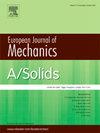A semi-analytical method for determining homogenized relaxation times and moduli in Prony series of a heterogeneous viscoelastic material
IF 4.4
2区 工程技术
Q1 MECHANICS
引用次数: 0
Abstract
This work introduces a semi-analytical method to obtain homogenized relaxation times and moduli in terms of Prony series of a heterogeneous viscoelastic material. This can be treated as an extension of linear homogenization theory which calculates homogenized elastic properties of a heterogeneous elastic material. The heterogeneous viscoelastic material is consist of multiple phases where each phase is assumed as a standard-solid viscoelastic material. The idea of so-called reduced-order-homogenization method is introduced to propose a set of residual-free governing equations with respect to the averaged strains and eigenstrains of all the phases. The set of governing equations can be rewritten as a set of ordinary differential equations (ODEs), which can be solved analytically to obtain relationship between the phase strains and the macroscopic strains. The solution of the ODEs stems from an eigenvalue problem, where the eigenvalues are the homogenized relaxation times. In addition, the relaxation moduli can be evaluated through the ODEs as well. Accordingly, a homogenized viscoelastic material in term of Prony series can be determined. Four sets of numerical tests are proposed to verify the semi-analytical method: unit cell tests, tension tests on a plate with a hole, pure bending tests, and torsion tests. The results from these tests demonstrate a strong agreement between the homogenized model and direct numerical simulations. Additionally, we compared our model against experimental measurements, further confirming the accuracy and reliability of our proposed approach.
确定非均质粘弹性材料的均质弛豫时间和模量的半解析方法
本文介绍了一种用非均质粘弹性材料的proony级数来求均质松弛时间和模量的半解析方法。这可以看作是计算非均质弹性材料均质性的线性均质理论的推广。非均相粘弹性材料由多相组成,其中每相均假定为标准固体粘弹性材料。引入降阶均匀化方法的思想,提出了一组关于各相的平均应变和本征应变的无残差控制方程。控制方程组可以改写为一组常微分方程(ode),可以解析求解得到相应变与宏观应变之间的关系。微分方程的解源于特征值问题,其中特征值是均匀化的松弛时间。此外,松弛模量也可以通过ode来计算。据此,可以确定一种以普罗尼级数表示的均质粘弹性材料。提出了四组数值试验来验证半解析方法:单元格试验、带孔板的拉伸试验、纯弯曲试验和扭转试验。这些试验的结果表明,均质模型和直接数值模拟之间有很强的一致性。此外,我们将我们的模型与实验测量结果进行了比较,进一步证实了我们所提出方法的准确性和可靠性。
本文章由计算机程序翻译,如有差异,请以英文原文为准。
求助全文
约1分钟内获得全文
求助全文
来源期刊
CiteScore
7.00
自引率
7.30%
发文量
275
审稿时长
48 days
期刊介绍:
The European Journal of Mechanics endash; A/Solids continues to publish articles in English in all areas of Solid Mechanics from the physical and mathematical basis to materials engineering, technological applications and methods of modern computational mechanics, both pure and applied research.

 求助内容:
求助内容: 应助结果提醒方式:
应助结果提醒方式:


